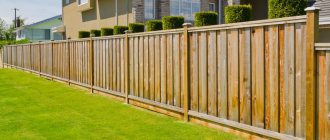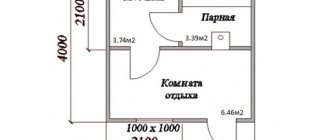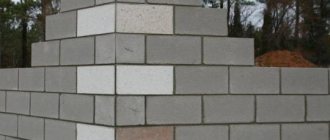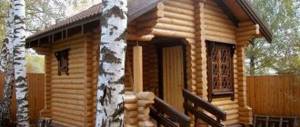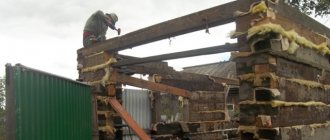Legal practice shows that the most terrible wars are fights between neighbors. Insults, curses, threats, ten-year legal battles, shots from double-barreled guns and arson of property. At the end of such a glorious and eventful military journey, as a rule, either a hospital or an unplanned long-term excursion to the sunny Komi Republic looms. Do you need it? You need to live amicably with your neighbors, and for such a wish to come true, carefully monitor the distance from the bathhouse to the neighbor’s fence. Whatever the case of leucorrhoea arises, in bad memory, it is a reason for war.
Distance of the bathhouse from the neighbors' house
If you do not take into account the requirements prescribed in SNiP, then in the event of an emergency, neighbors may demand to answer according to the law. It is important to comply with sanitary standards regulating the distance between the bathhouse and the neighbor’s house. This will eliminate the emergence of all kinds of conflicts with the owners of neighboring country houses.
The edge of the plot must be at a minimum distance from the sauna, equal to at least 1 m. The calculation of the distance of the structure from the neighbor’s house will be correct if we take into account not only the boundaries of the land plot or the distance of the structure from the fence.
It is important to take into account the location of each building relative to the future steam room, including objects on the neighboring site.
Recommended distances
Let's consider three options for placement schemes with minimum distances (see also the article “Permissible distance from the bathhouse to the fence: prerequisites and standards”).
First scheme (“A”)
Take this diagram as a standard when modeling your site:
- from a residential building:
- to the fence - 3 m minimum;
- to the bathhouse – 8 m;
- to the edge of the roadway - 5 m;
Helpful advice! We recommend that you always increase the distance from the house to the roadway as much as possible. This is required both by safety and environmental regulations and by the convenience of living away from noise.
- from the bathhouse:
- to the fence - 1 m, in this way it is possible to solve the question of what should be the minimum distance from the bathhouse to the neighbor's bathhouse - 2 meters, but this is the minimum, which everyone strives to do much more;
- to the edge of the roadway - 5 m;
Here you can see not only the distance from the bathhouse to the well and the distance from the boundary to the bathhouse, but also almost all the placement parameters for the selected building layout (diagram “A”)
- from the well:
- to the toilet, if, of course, it is on the street - 8 m;
- to the compost pit – also 8 m;
- from trees and shrubs:
- to the fence of the neighboring plot, if the tree is large - 4 m;
- to the neighbor’s fence, if the tree is small – 2 m;
- to the fence from the bushes - 1 m.
Second scheme (“B”)
Scheme “A” introduces minimum distances according to SNiP, but in practice they are guided by much larger values for the sake of convenience and greater safety:
- from a residential building:
- to the bathhouse – 5-8 m;
- to the greenhouse – 15 m;
- to outbuildings – 15m;
Another scheme and other recommendations (scheme “B”)
- from the well:
- to the bathhouse – 20 m;
- to the greenhouse – 20 m;
- to the outbuilding – still the same 20 m.
Third scheme (“C”)
Scheme "C" will allow you to have a good relationship with your neighbor.
The recommended distances from the border of garden plots according to the document “Instructions for Good Relations” are as follows:
- from a residential building – 3 m;
- from the bathhouse – 1 m;
- from outbuildings – 4 m;
Here it is convenient to consider not only the permissible minimum distance between bathhouses in neighboring areas, but also all other distances to neighboring objects
- from bushes – 1 m;
- from small trees – 2 m;
- from large bushes - 4 m.
In the photo, the solution to the question at what distance a bathhouse can be built received the minimum acceptable answer - only two and a half meters
Some nuances
When determining distances, the following nuances must be taken into account:
- For drainage from the bathhouse, it is recommended to use either a separate sewer channel or a drainage ditch; regardless of what is used, the distance to the fence can be reduced to 2.5 m;
- the distance from the trees is calculated from the center of the trunk; SNiP does not regulate the distance from the crown of a tree, so a heavily overgrown crown that covers the floor of a neighbor’s garden does not fall under legal requirements, only moral ones;
- the given distances for outbuildings and greenhouses depend on their nature - if the building contains pets, then the distance must be at least 4 meters;
- SNiP requirements also take into account the construction process of structures - space is also needed for placing building materials, and they should not cause inconvenience to neighbors on the site or on the street.
Helpful advice! It is impossible to provide for everything in the rules on paper. Therefore, going beyond the given distances is allowed, but this can only be done after drawing up a protocol of consent of all interested parties. We advise you to formalize especially difficult situations legally in order to protect yourself in the future, both from claims from neighbors and regulatory authorities.
Installation of different types of baths
Before erecting a structure, it is important to determine the type of future construction. Baths can be smoky or non-smoky, therefore, according to the regulations, the requirements for the first type of structure are as follows:
- Build taking into account the wind rose, since the wind can strongly blow smoke towards neighboring houses.
- Do not build in densely populated areas.
- Maintain a distance of 12 m from the bathhouse to the residential building.
Interior
If you plan to build a bathhouse that needs to be heated, then the distance from this building to the country house should be kept at 12 m. It is better if the building is located on the side of the site where the wind blows more intensely and frequently. This will further reduce the risk of fire hazard.
Smoke-free baths, or white baths, must be installed taking into account sanitary standards:
- away from the neighbor's house;
- arrange a ventilation system;
- waterproof the steam room.
Installing a building in white will significantly provide savings on the arrangement of a water supply system and sewerage system on one site. There are no norms in the legislation that prevent the placement of sauna structures together with residential buildings. In any case, it is better to coordinate such projects with architects and design specialists.
Combination of baths and other buildings
Modern baths are often combined with a garage structure, a residential building or a summer house. The legislation does not indicate anywhere that the construction of such structures is prohibited by regulations. Sanitary standards apply only to the construction of washrooms or toilets.
Location on
The distance from the bathhouse to the house is established by SNiP, SP and SanPiN standards. All standards have been developed for free-standing structures. A steam room in the form of a Finnish sauna is an extension, the operation of which is associated with certain risks:
- fire hazard;
- ingress of wastewater into the ground;
- soil contamination.
Fire standards for the distance from the bathhouse to various buildings are similar to the sanitary standards, which are regulated by SNiP 30-02-97 as amended in 2020 and SP 53.13330.2011. Fire safety standards have not been established for grouped buildings and structures, including those located in neighboring areas.
Sanitary standards for construction
Development of the site must be carried out strictly in accordance with the standards prescribed in the regulatory documents. The distance from the barn to the house is specified in SNiP 30-02-97 for development within the city and plots for individual housing construction.
SNiP 2.07.01-89 and SP 42.13330.2011 regulate the distances between constructed objects on the lands of non-profit cooperatives and settlements. The fire requirements of Federal Law No. 123-FZ apply to all categories of construction.
Sanitary standards
Sanitary and fire safety standards are the basis for drawing up the charter of a company for leasing non-commercial land . Deviations from the requirements are possible only in cooperatives with small plot sizes. The company's charter may stipulate:
- standards for the size of a country house;
- location of buildings on the site;
- the presence of a barn indicating its maximum dimensions;
- linking all buildings on the plan;
- types of utility units that are allowed to have in a given cooperative.
Location of buildings on the plan
If the plot width is small, it is possible to block neighboring houses and barns - the construction of two identical buildings adjacent to each other along the dividing line. For the placement of buildings on the land of non-profit cooperatives, the norms of SNiP 30-02-97 as amended in 2018 and SP 53.13330.2011 are mainly advisory in nature.
In the event of a territorial dispute or violation of development rules, the issue is resolved by the community board or a general meeting of all members. If it is decided that the outbuilding must be demolished, the chairman goes to court, attaching to the application a copy of the protocol with the decision of the board on this dispute.
Distances according to SNiP
At what distance from the house you can build a shed depends on its purpose and the degree of fire hazard. The distance can be 6–12 m to a fire-resistant neighboring house.
Sanitary and fire safety regulations prohibit placing outbuildings in front of the house on the side of the road.
Table of regulatory documentation depending on the type of land ownership.
| Plot | Set of rules | Building regulations |
| SNT, DNT | SP 42.13330.2011 | SNiP 2.07.01-89 |
| individual housing construction | SP 53.13330.2011 | SNiP 30-02-97 |
Outbuilding
A building for storing gardening tools and other household items can be located at a distance of 4 m from your own residential building and at least 6 m from a neighbor’s windows.
Proper bath design
To ensure that the operation of the sauna does not create problems for your neighbor, it is necessary to design it taking into account sanitary standards. This will reduce the risk of damage to the property of the owner of the site and his neighbors. The surface of the outer wall of the residential building should be taken as the reference point for the distance from the bathhouse to the neighboring residential building.
Typical location
To reduce the threat to the life and health of people, all aspects must be thought out, from the type of material used in the construction of the bathhouse to the distance separating the building with the steam room from the residential building. This will allow you to avoid fines for non-standard use of the bathhouse. It can be chopped or laid out of brick, but it is very important to comply with the requirements for the placement of the structure.
Construction of baths from different materials
When determining at what distance to place a bathhouse built from a particular building material, it is important to take into account the recommendations:
- Make the entrance to the steam room on the south side, since this is a warmer area and there is less snow in winter.
- Place windows in the western or southwestern part of the building, where sunlight reaches the maximum amount.
- Ensure good visibility of the structure and its entrance from the windows of the country house.
Layout of buildings according to SNiP
You need to build a wooden bathhouse on your own site at a distance of at least 15 m from the neighboring bathhouse structures. If a brick sauna borders a wooden building, then according to the rules, it is better to reduce the distance between the wooden structure and the bathhouse to 10 m. A brick building can be located at a closer distance (about 6 m from the gas bathhouse).
Distance from the bathhouse to the neighboring site: SNiP
The distance from the bathhouse to the border of the site is a parameter that can be determined fairly quickly if you turn to incompetent sources who are content with one figure. On any non-professional portal, this distance is determined by the figure of 800 cm (8 m), although sometimes you can even find 3 m or a meter, as for other structures that do not pose potential inconvenience to the neighbor.
The bathhouse is by no means a simple building due to the possible danger of fire, smoke, and sparks.
Near a country house
It can also become a source of possible wastewater pollution if the drains are not properly equipped. Fire distances are developed taking into account the material of construction and the type of sanitary and hygienic device.
The distance of the bathhouse from the border of the neighboring plot is regulated by the same values as from the fence.
When determining what distance should be to the fences, sanitary rules require that the building be connected to an autonomous drainage system. If they can ensure fast and safe disposal of waste, without polluting the neighboring area, no one will consider the bathhouse a stumbling block.
Connecting to a central sewer can minimize the setback if the neighbor is not disturbed by combustion products. The standards that must be met by law are not only the distance at which the boundary fence is located. These are other distances, for example, to green spaces or other structures behind the fence, on a neighbor’s property.
Winter
Standard distances from the fence and the house according to the law
Construction standards regulated by the current SNiP law, the new edition of which is also in force in 2019-2020, require compliance with the following distances:
- a bathhouse, as a structure that potentially poses a risk of soil contamination with wastewater, can be placed no closer than 3 m to any type of fence in accordance with SanPiN;
- the distance between the fence and the bathhouse can be reduced to 1 meter, provided that it is equipped with a high-quality drainage system and sewerage (this ensures that the neighboring land is not accessible to wastewater);
- the norm of 1 meter is maintained provided that a special drainage ditch is dug;
- You can place a bathhouse or sauna at a distance of at least 10 m from a residential building, this involves moving the building away from a fence made of low-flammable materials, and if directly opposite it there is a neighbor’s house under construction or already finished made of brick, stone or concrete with a wooden roof;
- it is possible to build a structure at a closer distance from the neighbors’ homes by agreement only if it faces the fence with its back side and does not have windows or vents (reduced to 6 m by agreement with the fire inspectorate);
- if the building is built from non-combustible materials and any neighboring object located opposite also has similar properties, the norm can be 8 meters;
- if at least one of the buildings erected on the same visual line consists partly of flammable materials, then the standard requires a 12-meter removal;
- a log bathhouse and a neighboring building with wooden elements cannot be closer than 12 m;
- SNiP requires a maximum distance of 15 m between two wooden structures for steaming and washing.
Location of buildings on individual housing construction and SNT sites in accordance with SNiP and SanPiN standards
In a garden plot, as well as in rural areas, green spaces are of great importance. The potential presence of a drainage ditch or drain to remove contaminated water makes it unsafe to be close to trees.
Requirements for placing baths
The distance between the house and the bathhouse must be observed in accordance with the rules regulated by SNiP 30-02-97 as amended for 2020, as well as SP 53.13330.2011. These documents indicate all the features of the placement of buildings on the site.
Distances between them must be maintained, since proper operation of various objects is impossible without this. In accordance with the instructions and fire safety requirements, the distance between the bathhouse and various structures should be:
- from a garden house in a village - more than 3 m;
- from a utility structure – from 1 to 4 m;
- from a well, toilet or composting facility – 8 m;
- from shower or sauna – 8 m.
Rules and regulations
The construction of the drainage system should be carried out at a distance of no less than 1 m from the fence of the neighboring area, where water should not flow.
It is better to cover the drains, which are a trench, with a layer of a mixture of sand and gravel.
Bathhouse construction and distances
Correctly determining the distance from the fence to the bathhouse means fulfilling the requirements of supervisory and governing bodies, which have the right to impose administrative penalties and fines.
Belonging of a bathhouse to sanitary and hygienic buildings requires compliance with the basic provisions of sanitary standards. The required distance between the bathhouse and the fence will ensure the comfort and safety of others.
Preparation
There are a number of legislative provisions that define in the Russian Federation the right of the owner to exploit his own possessions:
- These rights are guaranteed by the Civil and Land Codes, and the Code of Administrative Offences. Any citizen of the Russian Federation who considers that his rights have been violated can refer to the relevant articles of the laws in force in Russia.
- You need to be guided by the new edition of SNiP, adopted in 2020, if only because, unlike SP 53.13330.2011, it is not a construction recommendation that the court is guided by when making a decision, but is called the Law of the Russian Federation.
- The requirements of construction and sanitary standards for maintaining the required distance are determined not only by sanitary and fire safety measures. Compliance with them means a law-abiding attitude towards the rights of the same owners, whose properties are located immediately behind the erected fence. This does not mean that by law the minimum distance is observed unilaterally.
- The boundary between land plots is a two-way landmark, and both owners have the right to make claims and even file a lawsuit if they believe that a neighbor has violated some legal provisions.
- At trial, documentary evidence of damage or potential danger is taken into account. The basis for the appeal may be SNiP 30-02-97 as amended in 2020, which acts as a law binding on any form of land ownership (except ONT).
Oak and birch brooms
On former dacha plots, starting from this year 2020, the construction of garden and residential buildings is permitted. A gardening partnership that receives the rights of a legal entity has the right to determine what the norm for certain distances is.
But the construction of a bathhouse, barbecue, and other premises that potentially constitute a fire hazard in a garden plot, as well as sanitary and hygienic structures for which SanPiN applies, requires strict adherence to distance.
At the summer cottage
Table of distances from the fence and residential building to green spaces in the country.
Compliance with fire regulations
An important characteristic taken into account when dividing materials for construction into classes is fire resistance. This property is important to consider when placing a sauna. The samples used for its construction can be flammable or non-flammable, for example, wooden beams or bricks. Their division into classes is as follows:
- Non-combustible including stone, concrete, brick - 1st class.
- Mixed, when wooden floors are combined with steel elements - 2nd class.
- Combustible including wood materials and their substitutes - 3rd class.
When choosing a particular material, it is important to pay attention to the division of samples within the classes listed above depending on the use of impregnation. Buildings with roofs made of non-combustible materials should be located at a distance of 6 m between them. The distance from the bathhouse to the neighboring house should be 12 m if the roofs of the buildings are made of flammable materials.
Standard distances
The distances between a brick residential building and a wooden roof and a sauna should be selected taking into account the type of flooring or roofing material of a building with a steam room:
- flammable – 10 m;
- flammable - 12 m;
- woody – 15 m.
Designing a bathhouse requires a careful approach, maintaining the distance between the stove units inside the steam room. The equipment inside the bathhouse must be installed in accordance with all rules and requirements of sanitary and fire safety.
When building a bathhouse, you should remember that the cause of a fire can be not only the contact of wood with fire. Prolonged heating of equipment to temperatures above 100 °C can cause a fire. In order to prevent a fire, it is important to observe not only the distance of the bathhouse from residential buildings and other objects on the site, but also to correctly install high-quality equipment inside the steam room.
What other standards to consider?
When placing buildings on the site, it is also necessary to take into account the norms of distances from the neighbor’s fence:
- to the toilet on the street in SNT or individual housing construction - 1 meter;
- to the greenhouse on the garden plot or in the vegetable garden - 1 meter;
- to a residential building in a cottage village or on a summer cottage - 3 meters.
Minimum distances in SNT according to SNiP
These standards are in the nature of recommendations, however, they must be followed to avoid conflicts with neighbors. Often disputes arise due to the installation of blind and too high fences. Such disagreements often lead to litigation.
Planning as the basis of construction work
The location of the bathhouse on the site is not the whim of its owner, but very often the result of a confluence of many circumstances. The areas are different. Somewhere, a dozen hectares of reserved land are attached to a palace-mansion, and somewhere, less than six acres, are huddled on slopes, inconveniences, and old, many years ago, abandoned landfills. It is clear that the neighbors and the sun-faced owner of the palace do not care about the rules for building a bathhouse on the site. On the one hand, due to the lack of laws and rules for such a figure, on the other hand, due to the absence of these same neighbors. At least those who will appeal something. Another thing is a standard piece of land for the owner of this life - the people. On less than 6 acres, to build a house, plant a garden, arrange a vegetable garden, a gazebo, and even a bathhouse, and not make enemies in the process, is akin to high art.
Finding out how much space the bathhouse takes up on the site, how many meters from the fence and other objects is a good reason to pick up a tape measure and go out into the yard.
The standards for building a bathhouse on a summer cottage are clearly stated and, if you follow them, many problems can be avoided. Let's look at the table:
| Type of development or location of the property | Distance, in mm. |
| Your dacha is located in the east, south or west, relative to your neighbors’ dacha | Not less than the distance from the lower level of the plinth to the cut of the ridge |
| From the house to the border of the roadway | Not less than 3000 |
| Garages can stand alone, be built in, or attached to other outbuildings within the site | The distance from outbuildings to the boundaries of streets and street passages is at least 5000. In relation to the garage, it is allowed to place the entrance gate on the line connecting with the street passage |
| Outbuildings may be adjacent to the garden house | From buildings to the border of the adjacent plot at least 1000 |
| From the garden house to the toilet, if one is located outside the house bathroom, and the street cellar | 12000 |
| From a permanent home built from mineral building materials to a neighboring house built from wooden elements | 8000 |
| From a permanent wooden house to a neighboring wooden house | 10000 |
| From the house to the street boundary line | 5000 |
| From a well, a water well to a latrine, a composting pit, a place for temporary storage of household waste | 8000 |
| Distance from home to bathhouse, summer shower | 8000 |
| From the bush to the border of the neighboring plot | 1000 |
| From the trunk of a medium-sized tree to the border of the neighboring plot | 2000 |
| From the trunk of a tall tree to the border of the neighboring property | 4000 |
These are general site planning rules that allow you to generally navigate the question of where to build a bathhouse on the site.
